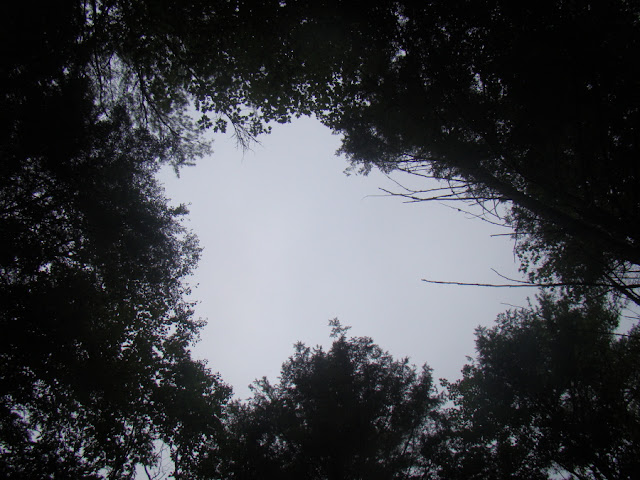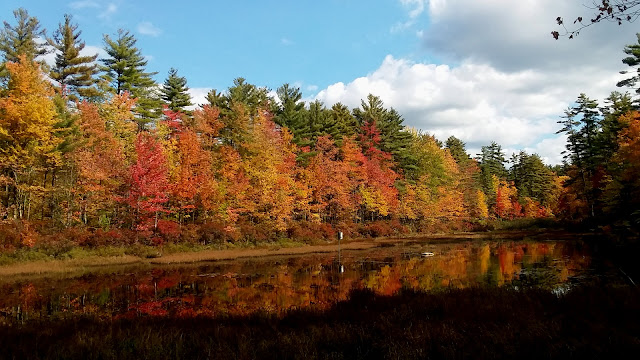First, it's time to revel in the beauty of New England's maple trees in autumn. The sugar and red maples are hitting their peak colors and will be vibrant throughout the Lakes Region this week. Last week the lower elevations in the White Mountains were close to peaking.
 |
| Franconia Notch on an overcast day. |
The beech and oak trees will follow behind shortly. Talking about beech trees, when I was looking at beech nuts back in August ("Beech Nuts", August 29) I mentioned that beech are patient trees, growing slowly in the shade waiting for their moment in the sun. Well, I recently came upon just such an opportunity for them or some other plant that's in the right place at the right time: A stand of pines had blown over in one of our recent wind storms.
A whole group of them was ripped up at the roots and put down on the forest floor.And it was obvious why they couldn't stand up to the blow:
Their roots just peeled up the foot or two of soil on top of a granite slab.
These trees had entrusted their life to the thin soil on top of the granite that New Hampshire is famous for, but it couldn't hold the them in place as the trees grew taller and their wind loading increased. The soil in New England is only about 20,000 years old, re-building slowly ever since the glaciers from the last ice age scraped the granite clean. (Sometimes one shouldn't build one's house upon the rock.)
But these trees' demise makes an opportunity for other plants to grow - look at the hole created in the forest canopy:
 |
| It's not a big hole, but some light will get through. |
Throughout this hemlock-hardwood-pine forest there's almost nothing growing down in the understory due to the lack of light - just a few ferns and mushrooms, the latter of which don't photosynthesize, so don't need sunlight.
 |
| Almost nothing grows in the shade of this closed forest canopy. |
But now this opening will let sunlight bathe a small patch of forest floor, providing the life-giving energy that plants need to live. Plants that want to take advantage of this opportunity will have to act quickly; in just a few years the surrounding trees will greedily spread out their limbs to take advantage of the opening, and the hole will be sealed off. But fast growing plants that have tiny sprouts or even seeds waiting in the soil might get enough of a head start in this window of time to make a go of it. And if successful, it will bring much needed diversity to a rather homogeneous forest - a miniature example of what happens after a forest fire. I'll keep an eye on it over the next few years and see if any opportunistic plants take advantage of the moment.
Now a quick loon update: Our female loon is still on the lake and Jimmy is still hounding her for his meals.
 |
| That's mom behind Jimmy as he asks when dinner will be served. |
And finally, it's the time of year when you get a morning wake-up call at exactly 30 minutes before sunrise - that's when duck hunting begins for the day. One day this week we were awakened with the sharp report of six shotgun blasts all at once as the clock struck 6:24am. But alas, at least one got away, as this pretty duck was seen an hour after the sunshine illuminated the red maples along the shore of Lake Wicwas.
 |
| At lease one duck survived the hunt. |
I can't tell if this is a mallard or an American black duck enjoying our beautiful fall foliage. I hope you too can get out to savor the beauty of fall in New Hampshire this weekend or next.






No comments:
Post a Comment